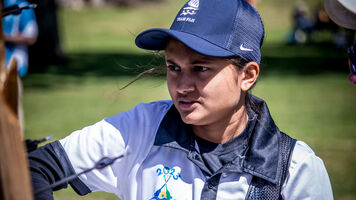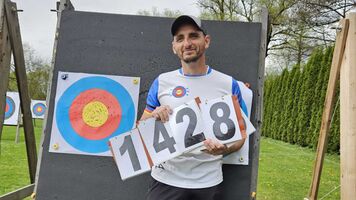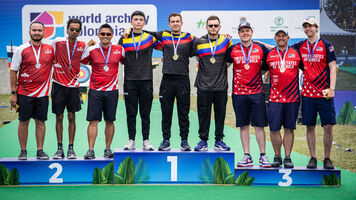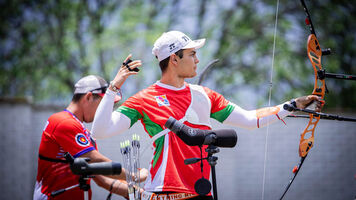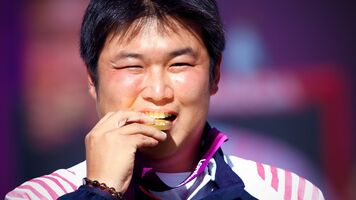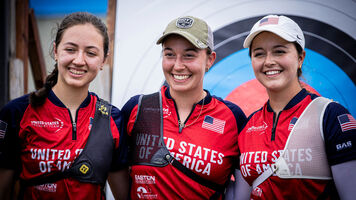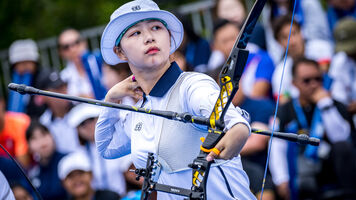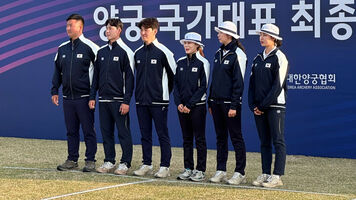This content is archived and as has not been processed. It may contain unformatted text or images, broken links or out-of-date information.
Archery, the Athletes’ Committee and life according to Viktoriya KOVAL (UKR)
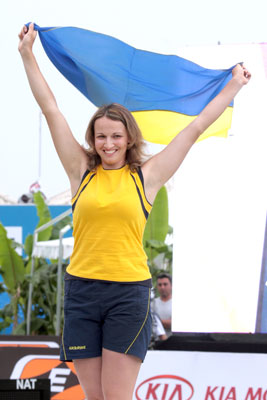 The Ukrainian archer Viktoriya KOVAL is the Chairwoman of the World Archery Athletes’ Committee and a member of the World Archery Executive Board. In a recent interview, she shared her thoughts on archery, Olympism, and her role in sports administration.
The Ukrainian archer Viktoriya KOVAL is the Chairwoman of the World Archery Athletes’ Committee and a member of the World Archery Executive Board. In a recent interview, she shared her thoughts on archery, Olympism, and her role in sports administration.
What is the role of the World Archery Athletes’ Committee?
Our role is to represent the archers. We are the link between World Archery and the athletes, making sure that communication flows freely between the two parties. Our committee gathers the opinions expressed by the archers and communicates their main messages to the Secretary General of World Archery Tom DIELEN and to the Events Director Juan Carlos HOLGADO. We also ensure that information travels in the other direction by communicating World Archery’s messages to the athletes. How did you start working with the Athletes’ Committee of World Archery? My involvement with the Committee was unanticipated. In 2009, the World Archery Events Director Juan Carlos HOLGADO and the Secretary General Tom DIELEN proposed my candidature for the Athletes’ Committee. I decided to give it a try and accepted their proposal.
I was chosen because they wanted to have a member who would represent the Russian-speaking athletes. We are a strong force in archery: not only do competitors from all of the former Soviet countries speak Russian, but many Western countries also have Russian-speaking archers. Notable examples include Veronika HAIDN TSCHALOVA from Germany, Natalia VALEEVA of Italy, Khatuna LORIG of the USA, and the list goes on.
Our committee is very diverse: I speak English and Russian, Linda OCHOA (MEX) speaks English and Spanish, Wietse VAN ALTEN (NED) speaks English, Dutch, and German, Matija ZLENDER (SLO) speaks Slovenian and English, Pippa BRITTON from Great Britain (who represents the para-archers) speaks English, and HAN Seung Hoon (KOR) speaks English and Korean. We can therefore communicate with our archers in several languages. We compile key points of view on important matters and group them by language and by category (recurve, compound, field, para-archery, etc.)
What is the main concern that the Committee is addressing at the present time? For instance, we are talking about the Olympic Games and their qualification system. There are some discussions about the wild card quotas and based on our recommendations, World Archery has taken this discussion further to the IOC and ASOIF.
Another important point of discussion involves the possible introduction of a mixed team category or the inclusion of the compound class at the Olympic Games. These considerations are very important because, in most countries, there is no support for sports that are not Olympic disciplines. If compound became an Olympic event, the worldwide calibre for compound archery would increase.
Archery has only four events at the Olympic Games: two for individuals and two for teams. This represents a small number of events compared to other sports like athletics or swimming. We suggested to World Archery that we ought to try to obtain an additional event. World Archery has now presented this proposal to the International Olympic Committee. As of yet, we do not know what the outcome will be: deliberations on proposals such as this take a long time and the status quo can be difficult to change.
With the Olympic pole vault champion and IOC member Sergei BUBKA (UKR)
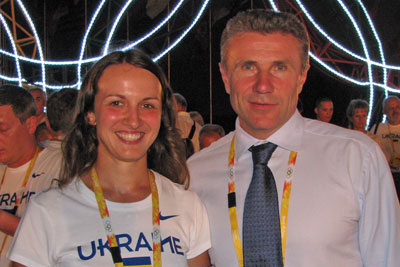 What other examples are there regarding the Committee’s main points of concern? Another important point of discussion circles around the inequalities that are intrinsic to the side of the field from which an archer shoots. Depending on where the wind comes from, an archer is either protected or not. If the wind crosses from right to left, you are protected if you stand on the right side, but you suffer from the cross-wind if you shoot from the left. This is something that we could potentially amend. It was proposed that, in the team competition, the three members shoot separately, with one archer shooting from the right, one from the middle and one from the left.
What other examples are there regarding the Committee’s main points of concern? Another important point of discussion circles around the inequalities that are intrinsic to the side of the field from which an archer shoots. Depending on where the wind comes from, an archer is either protected or not. If the wind crosses from right to left, you are protected if you stand on the right side, but you suffer from the cross-wind if you shoot from the left. This is something that we could potentially amend. It was proposed that, in the team competition, the three members shoot separately, with one archer shooting from the right, one from the middle and one from the left.
Another hot topic has to do with the new rules. Why do compound archers shoot from 50 metres while recurve athletes shoot from 70, when compound supposedly allows for more precision? This is a delicate issue: World Archery needs to differentiate the rules of the compound division from those of recurve if we want to have compound included in the Olympic Games. The Committee wants to help World Archery find new solutions to this issue.
What do you think about the evolution of archery over the last few years? Archery has undergone a very big and positive evolution since the World Cup was launched in 2006. The overall level of competition has increased considerably, and the finals have become more visible to live and television spectators. This last point is very important to the dissemination of awareness about our sport.
In my hometown of Kharkov, for example, we have two million inhabitants but only one archery club. Nevertheless, the club is very successful in terms of international results: it recently produced Olympic medallists Viktor RUBAN and Oleksandr SERDYUK, among other notable archers. We have a strong tradition and very good coaches. However, not many people know about archery, and we need more children to try the sport. Television coverage encourages awareness and new participation. For example, the Olympic victory of Viktor RUBAN was excellent at promoting archery in Ukraine after 2008, because people saw images of his victory on television.
What can you say about the role of television in the development of archery? TV images are the best vehicle for promoting archery as TV can reach vast audiences worldwide. After discovering archery on TV, maybe young children will be tempted to try the sport and will go on to become the next Olympic champions!
The showcase of the World Cup Final in spectacular locations was an excellent idea. The World Archery Events Director Juan Carlos HOLGADO is a top-level manager who has lots of good ideas. World Archery is very fortunate that it has a great team that it can depend on for the development of our sport. We are also lucky to have people like the World Archery President Prof Dr Ugur ERDENER who take part in many conferences worldwide and increase archery’s visibility.
The athletes have had to adapt in some ways to rules made for television. Can you discuss these adaptations and their impact on the archers? Archery TV and television broadcasts are tailored to the spectators. In that respect, we have had to adjust some rules to make archery more TV-friendly. For example, the format of the final rounds is designed for TV rather than for the athletes. Archers don’t like the 20-second time limit in the finals; it is too stressful. What do you do if it’s windy? Remember last year when it was so windy at the Antalya World Cup in 2011 that even the Korean women shot misses? The matches go very quickly. This format does not favour the archers. It is, however, very good for TV. If we want to develop our sport, we must make it TV-friendly. We do, however, have to find a balance between what is TV-friendly and what is also archer-friendly. What about yourself, how did you become involved in archery? Archery is a tradition in my family: my mother was the champion of the USSR and she is now a coach. She competed in archery when she was pregnant with me, and I obtained an Olympic spot for Ukraine last year when I was pregnant with my daughter Diana! I discovered the sport at the age of 3, but didn’t shoot seriously until I was 12 years old. I had tried many different kinds of sports, including athletics, gymnastics, and volleyball, but by the age of 12, I started to take archery seriously. In 2001, at age 18, I competed in my first international event: the European Junior Cup in Croatia, where I won my first international medal. I now have two coaches: Alexander XENOFONTOV and my mother. How do you combine elite sports with taking care of a baby? Very well! I have a normal life for a Ukrainian woman (laughs): I have a husband, a baby, and a job that is archery. In my country, all of the National Team members are professional athletes funded by the Ministry of Sports. We receive a salary equivalent to an average Ukrainian salary. It’s fantastic to be paid to do what we like best, because archery is my passion. Everything will go well for me as long as I keep shooting well: if I stop obtaining good results, younger sportswomen might take my place on the team.
I started shooting again one month after giving birth to my daughter. I take my baby to training with me; my mother and my husband are coaches so the whole family works together at the field. I took part in my first competition in Ukraine in late April. My result of 1328 was good. I hope to compete in prominent international competitions very soon!
How is your level of shooting and training these days? I shoot nearly 150 arrows a day in an average of two to three hours. I used to be on the team for major events but I will not compete at the Olympic Games this year. However I’m going to be present in London as a Member of the World Archery Executive Board.
What is your message to the athletes and to young archers?
The most important message is to communicate well with other sports, other countries, and other National Olympic Committees. I hope to help the information travel effectively between the organising committees, the sport federations and the athletes.
As elite archers, we have a wonderful lifestyle. We train, we shoot in competition, we have international friends that we meet on the circuit… All of the emotions that we share in competition are very intense, and those include not only the emotions that we feel ourselves but also those that are emitted from other champions like Brady ELLISON (USA). If you want to become one of the best archers, you must dedicate five to ten years of your life to the sport. This is true not only for archery, but also for life in general. If you really want it and work hard, you can achieve your dreams.
Will your daughter be an archer? I think so. Both my family and my husband’s family are archery families. I guess she should try our sport too! I will, however, let her choose what she wants to do with her life.
Thank you and all the best!
World Archery Communication



